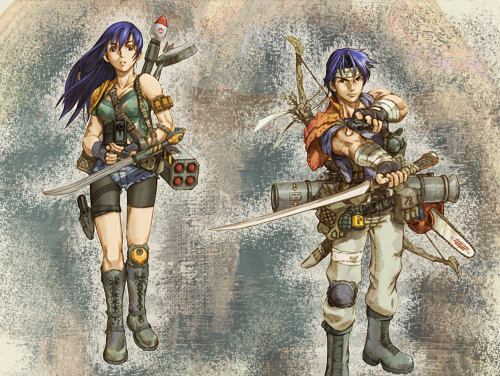SaGa Love (Especially 2)
There are a few games that I absolutely love, despite all reasons I would ever want to hate them. Part of the reason I like them so much, I’ll gladly admit, is nostalgia. Most such games left an impression on me growing up, and overcoming the (often many) frustrations and learning to play them the best way possible was a big inspiration for me to pursue problem-solving and mathematics.
Another, more significant part, is that they really rock. Seriously, these are some damn good games, even when they have a few knocks against them. It’s not a “they shore don’t make’m like they used ta” feeling, because one of these games is Persona 3. It’s not even a “this game is good because it was made by X” because I dislike Suikoden 4, Wild Arms 4, Persona 2… and so on. Simply put, it’s not all fanboyism and it’s not all nostalgia. A significant amount of the reasons I like these games is because they’re a blast to play. In some cases, the story is deep or satisfying enough that it doesn’t matter that it’s not.
All these words to say I love SaGa 2 (which, I may add, is actually Final Fantasy Legend 2 in disguise, or vice versa) I have just written a review for videolamer, as usual, but there I try to pursue some vestiges of professionalism. This game is fantastic; how many games let you shoot rhinoceroses with a PSI rifle? How often do you get to battle (scaled up) microphages using a robot with a battle-ax? The answer is not enough. The best part of the game is its difficulty; ironic when most of my favorite games are easy. In SaGa 2, your party is perpetually armed to the hilt with the most up to date weaponry and you are still just barely hanging on against the hordes of flying fish, oversized spiders, goblins, terrorists, the occasional demigod, robots, and so on. Some of the original SaGa 1 / FF Legend artwork is evocative here:

The original SaGa is perhaps more realistic in feel – a game more in tune with the human condition, you might say. The Tower evokes the lure of knowledge despite danger, and the characters are clearly adult (unusual for an RPG, sadly). Perma-death is partially implemented (it is prohibitively expensive to keep someone in your party if they keep dying) and your party has to adapt to survive – I always end up swapping out a party member for a fresh one no matter how hard I try not to. Other aspects – the hidden wet-world and dry-world in the tower, the fish statue land (this thing STILL exudes mystery to me, the others have some meaning)… it is a more philosophical game than one would think at first glance.
SaGa 2’s anime style fits more with the spirit of adventure. Rather than a search for meaning, or forbidden knowledge, your main character is looking for their missing father. In the end, the goal becomes fuzzier but your party is still running around righting wrongs. The tone is significantly more childish, especially when the main plot-line gets lost and you get sidetracked saving the oppressed peoples of ancient Edo from their banana-banning masters.
Despite this I love SaGa 2 more for its intense combat and more rewarding battle system. SaGa 1 is a jumbled mess, seemingly a bunch of themes and morals with a game tacked on. SaGa 2 is also disconnected plot-wise. “Hey, you know what would be cool? Frickin’ VALHALLA as a world! And get this – when you kill Odin he doesn’t give you re-dos on battles anymore!” There are no consistent themes, very little in the way of overarching plot. Merely a bunch of worlds just floating around. Despite all that, it still manages to give me the same feeling of adventure as the more famous Lunar games and Skies of Arcadia. As Steve Brust has said about his writing style: “…And now I’m going to show you something really cool.” The game simply keeps getting better as you progress, with your party and the enemies consistently getting stronger and more complex.
So yeah – long story short, I played the DS remake of SaGa 2 – very playable if you have played the original, although katakana and hiragana would be useful for weapon / item names. It is very much a good extension of the original. The additions are disconnected, jumbled, occasionally confusing – but they add to the game in much the same way as the plot. They’re another nifty feature – another weapon – perhaps a chain-sword, rifle, or a rune axe – hanging off the belt of one of the characters.
The DS remake has done justice to some of the only work of Akitoshi Kawazu that I enjoy (and man, do I enjoy it). Square Enix needs to localize it so I can buy it a second time.